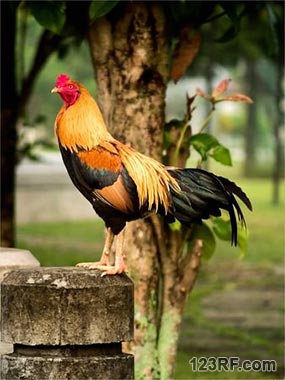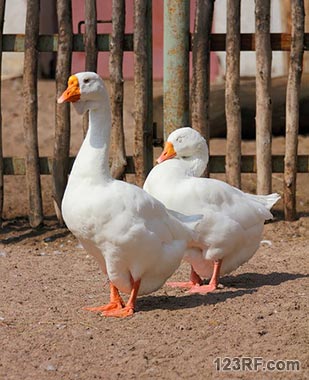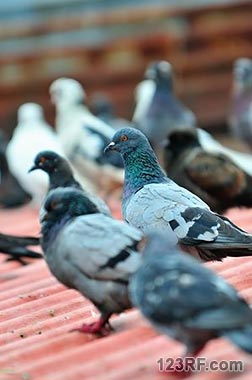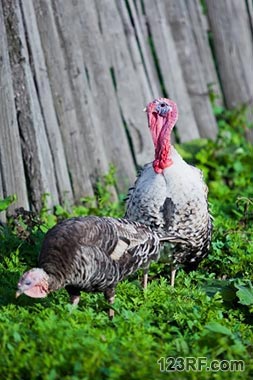Every single day the average American throws away 1/3 of all food coming into the home. To make matters worse, commercial farms routinely destroy livestock and drive food prices up even more with additives that endanger your health. If you think food is expensive now, you are sure to be in a worse situation when SHTF and food production stops altogether.
Since meat and eggs serve a prime part of many diets, learning how to raise and propagate these 5 farm birds can make it easier to get through any food shortage that comes your way.
1. Chickens

Housing Requirements – Most people build a chicken coop where chickens can live and lay their eggs without falling prey to hawks and other native predators. If you are only planning to keep two or three hens and a rooster, it may be possible to let them live right in your home.
That said, be prepared to start training the birds from when they are chicks to live in this type of environment. Chickens are very smart, and you will find them enjoyable to own as pets and egg layers.
Food – With the exception of avocados, chickens can eat just about anything. You can use commercial egg layer pellets combined with chopped oyster shells for added calcium. Table scraps and free ranging will also give hens a wider range of nutrients that will contribute to increased egg production.
Advantages – Chickens are legal to keep in most areas, and tend to be easy to keep. Extra eggs and meat can also be sold provided you have required licenses and appropriate area for raising chickens. Since the organic egg market is a booming industry, you can make a good bit of money on this market.
Disadvantages – Roosters can be very noisy, and some neighbors may not like the odor that comes from the chicken coop. Since chickens love to eat insects, they can get poisoned by insects that have been in contact with insecticide.
2. Geese

Housing Requirements – Since mature geese have relatively few predators, they can live outdoors in warmer climates. You can make a coop for them, but it will require a good bit of space. For best results, provide a lake for swimming and suitable cover for hatching.
Food – Geese eat grass, grain, and corn.
Advantages – Since geese are technically water fowl, they are not susceptible to diseases commonly found in other farm animals. They also get fairly large, and produce a good bit of meat in a short period of time. Geese are also very territorial and can act as farm sentries and guards.
Disadvantages – Geese can be very aggressive towards other animals.
3. Ducks

Housing Requirements – It usually requires a duck house and fencing if you are going to collect eggs.
Food – You need seeds, grain, and insects to feed the ducks. If you are going to allow ducks to free range, make sure insects in the area are not consuming insecticides.
Advantages – Ducks tend to be hearty in all kinds of weather and produce eggs and meat fairly quickly. Since many people prefer duck eggs, they can be the foundation of a good organic farm business. Even though ducks are smaller than geese, they are also very territorial and will act as property sentries.
Disadvantages – Ducks can be smelly and noisy, similar to chickens. Male ducks are very aggressive, and all but one must be slaughtered each year in order to preserve flock coherence.
4. Pigeons

Housing Requirements – Pigeons prefer to live high off the ground, and need to be able to fly if they are going to grow properly. An upstairs room covered with straw or wood shavings will make an ideal living space.
Since pigeons are easy to train, you can let them out for a few short flights each day, and then call them in before they become targeted by predators.
Food – Pigeons eat grains, berries, and seeds. You can also buy pigeon feed that will supply all required nutrients.
Advantages – Pigeons are fairly small, and live comfortably in flocks. They also reproduce quickly and can be used for meat faster than other birds.
Disadvantages – Pigeon living quarters must be cleaned on a daily basis in order to control odor and disease.
5. Turkeys

Housing Requirements – Even though turkeys are similar to chickens in housing needs, they are larger birds that require more space.
In addition, turkey poults require more care in the sense they can be drowned by everything from a deep water dish to rain coming from the sky.
Food – Feed them seeds, nuts, worms, grains, insects, small lizards. Commercial turkey feed can be used to supply all required nutrients.
Advantages – Once they grow past the poult size, turkeys tend to be fairly self sufficient. They can forage for themselves easily, and will keep good control of the insect population.
Disadvantages – You will need to buy heritage turkeys if you plan to have a sustainable flock. Unfortunately, more modern strains are unable to reproduce without artificial insemination.
Once you taste fresh eggs or meat from organically raised animals, you will never want to go back to commercially grown products. Therefore, as you consider how to feed yourself after SHTF, it is important to consider raising farm birds.
Aside from being a perfect source of inexpensive food during bad times, you can make money on your flocks and build up a barter network for all your current needs.





































































10$ a month to feed a chicken doesn’t sound right. I don’t spend near that to feed 6 hens and a rooster. They don’t free range but they do have a very large enclosure. We purchase 1 bag of pellets every three months or so. In the spring when egg production is the highest it may get down to 1 bag every 2 months. A 50 lb bag cost $36.00. So I guess that breaks down to 2-3 $ a month per bird.
10 a day to feed turkeys? You must mean per month.
I’m surprised quail was not on this list. We have just started with quail, and they seem like they will be a viable bird. There are no restrictions (in the city) as far as we know…and so you can have a lot more-but their eggs are smaller.
Does anyone have any experience with these birds? And what do you think about their viability in a shtf scenario?
Coturnix quail are by far way easier than chickens, ducks, geese, turkeys or any other bird. The each only require a 10″ by 10″ area per bird, can be easily raised indoors or outdoors, lay an egg a day from 6 weeks of age. They are easy to handle, and the eggs taste the same as chicken eggs. You can feed 40 for the same as feeding a half dozen chickens. They are very forgiving if you try to incubate the eggs yourself as they hatch in only 18 days, start laying eggs at approximately 42 days old, where a chicken takes 21 days and doesn’t start laying eggs until they are 6 to 8 months old. There are more than six varieties of coturnix quail and you can pick the one that is right for you and your situation.
You missed the easiest and best of all – Guinea Fowl.
Guineas are very noisy, but they have really cool feathers if someone can use them for fashion or fishing.
in the chicken category, variety makes a big difference. Bantys are small and feisty. they are known to attack snakes and kill them, and probably eat them. I remember seeing one banty hen attacking the head, and another the tail. poor snake did not have a chance. Banty hens will roost in the high branches of trees. They will always be the first chickens to alert to any predator, especially hawks. One negative: they may wander off your place and disappear.
These and guineas are by far the most self-sufficient of all “chickens”.
Guineas are very loud, and give away your locaion.
$10.00 bucks a day to feed a Turkey?!!!!???@. Well maybe. Caviar is costly!
other species of birds are quail, require little space, make no noise, and do not eat much, they produce small eggs.
I raised and sold Americaunas and many of the chicks went on to win shows. They are smart and understand what you are saying. I had them at a time when I was having issues at work as well as at home, and I would spend lots of time out in the coop talking to them. They are lots cheaper than a shrink!
I had 25 hens and 2 roosters and found that to be the right numbers to have all fertile eggs. The variation of colored eggs they produce, made Easter a cinch. All you have to do is boil the eggs as they will be pink, green, blue, and many variations of these colors. The only issue with chickens is they are curious and if the coop is set up where they can put their heads through the wire, they become prey for raccoons. I lost my entire flock in one night. The raccoons didn’t even come into the coop, it looked as if they just walked around the coop and beheaded the chickens when they stuck their head out to see what was going on.
I haven’t raised any birds since then.